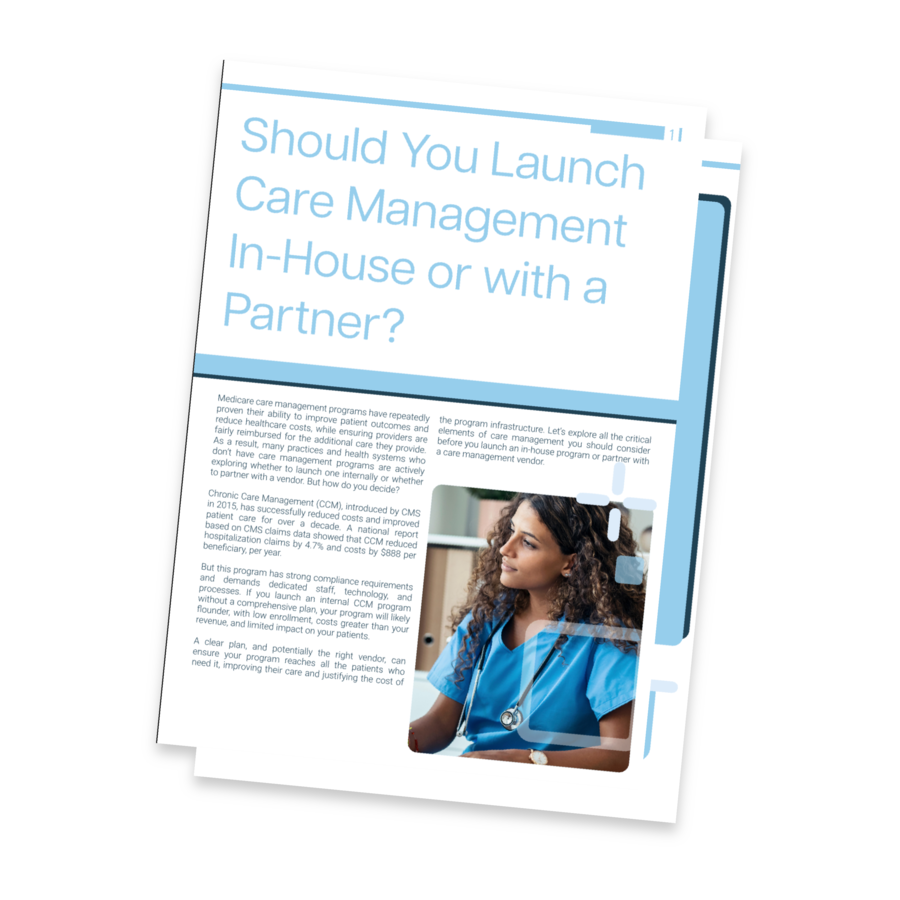
Talk with a ChartSpan Representative Today!
Our team is ready to help you improve patient care and outcomes.
Blog
Why Cultural Competence Is Essential to Delivering Patient-Centered Care
Every patient brings more to an appointment than their symptoms or medical record. Their culture—shaped by beliefs, values, language, and life experiences—affects how they understand health, communicate with providers, and make decisions about treatment. When care teams recognize and respect those differences, they strengthen trust and improve the quality of care for every patient.
Cultural competence refers to a provider’s ability to deliver care that reflects a patient’s cultural background and preferences. It’s a core component of patient-centered care, which seeks to understand each person’s needs and priorities rather than focusing only on the condition being treated. This approach is especially important for patients managing chronic illnesses, who rely on ongoing communication and personalized support to stay engaged in their care.
When cultural awareness is lacking, it can lead to communication gaps, reduced treatment adherence, and poorer health outcomes. Patients who don’t feel understood or respected may disengage from care or delay seeking help, making it harder to manage chronic conditions effectively.
For healthcare organizations focused on improving equity and outcomes, building cultural competence within care delivery is an essential step forward. Programs like Chronic Care Management (CCM) and Advanced Primary Care Management (APCM) can help practices put this into action by building meaningful relationships, addressing cultural barriers, and tailoring care plans to each patient’s context.
What is cultural competence in healthcare?
Cultural competence in healthcare is the ability of providers and organizations to deliver care that respects and responds to patients’ cultural, social, and linguistic differences. It goes beyond recognizing diversity, requiring providers to adapt communication, treatment, and care practices to align with each patient’s values, beliefs, and background.
Culture shapes how patients interpret symptoms, evaluate treatment options, and follow care plans. These differences can affect medication use, dietary choices, preferences around physical exams, and how patients seek help. When cultural factors are not addressed, the result is often miscommunication, incomplete treatment, and lower patient trust and satisfaction.
Cultural humility is an essential piece of cultural competence. It is a practice of continuous self-reflection in which providers consider how their own perspectives and assumptions influence care. Instead of assuming cultural knowledge, cultural humility requires providers to listen, ask respectful questions, and make adjustments based on what the patient actually needs.
Culture itself is complex and shaped by many factors, including race, ethnicity, nationality, language, gender, religion, socioeconomic status, and education. Recognizing this complexity helps providers avoid generalizations and instead approach each patient as an individual whose decisions and preferences are influenced by a unique combination of experiences.
When healthcare teams integrate cultural competence into everyday care, they strengthen communication, reduce disparities, and create a more inclusive environment where patients feel understood and supported. For people with chronic conditions, whose care depends on repeated interactions and long-term adherence, culturally informed approaches reduce barriers to engagement and support better management of disease.
Components of cultural competence
Cultural competence develops through a combination of awareness, knowledge, skills, and attitude. Each component plays a role in shaping how providers interact with patients and make care decisions.
- Awareness: Recognizing that every provider brings their own cultural background and biases into patient interactions. Awareness means understanding how those perspectives influence communication, expectations, and care recommendations.
- Knowledge: Gaining an informed understanding of how cultural beliefs and social factors affect health behaviors and healthcare access. This includes learning about, but not assuming, common cultural norms related to diet, family structure, or decision-making.
- Skills: Applying that understanding in practice by communicating clearly, using interpreters or translated materials when needed, and tailoring care plans to align with each patient’s cultural context.
- Attitude: Approaching every patient with openness, respect, and a willingness to learn. A culturally competent mindset views patients as partners in care and values their insight into what approaches will work best for them
Together, these elements form a framework for equitable, patient-centered care. Cultural competence isn’t static; it’s a continuous process of reflection and improvement that helps providers deliver more personalized, effective support to every patient they serve.
Why cultural competence is important for patient-centered care
Patient-centered care is built on the idea that treatment should reflect a patient’s individual needs, values, and preferences. Cultural competence strengthens that foundation by helping providers understand what drives each patient’s health decisions and how to adapt care so it’s both clinically effective and personally relevant.
Cultural competence in Care Management
This is especially critical in Care Management. Patients living with conditions such as diabetes, hypertension, or heart disease often need consistent, long-term support to maintain their health. When cultural and personal factors are overlooked, care plans can miss the mark. A patient is less likely to follow recommendations that don’t align with their cultural lifestyle or daily routine.
Providers who take time to learn what motivates patients and where cultural beliefs may shape behaviors can design plans that patients are more likely to understand, accept, and sustain. Care managers can then employ cultural competence while helping patients update and maintain their care plans, by suggesting adjustments or new goals that align with the patients’ lifestyle and values.
Addressing language barriers
Language is one of the most significant barriers to effective, patient-centered care. Individuals with limited English proficiency often delay seeking care because they’re unsure how to navigate the healthcare system or communicate with providers. Language barriers can also contribute to diagnostic or treatment errors. Culturally competent care, such as in-person or phone translation services and printed materials in multiple languages, helps eliminate these barriers, improving comprehension and enabling patients who speak other languages to access healthcare services with confidence.
Health education
Culture also influences how patients engage with health education. Knowing which topics may be considered private or taboo allows providers to approach them thoughtfully without making the patient uncomfortable.
Culturally competent patient education goes beyond translation, presenting information in a way that matches the patient’s learning style, values, and real-world context. When education feels relevant and respectful, patients are better equipped to understand their diagnosis, recognize warning signs, and follow care instructions accurately and consistently.
Building trust
Trust naturally follows from this kind of understanding. When patients feel respected and supported, they are more likely to share concerns, ask questions, and stay engaged in their care. That trust is especially critical in chronic care, where long-term adherence determines outcomes.
Unfortunately, research shows that many ethnic minority patients report lower satisfaction with their care, which can lead to delays in treatment or medication non-adherence. This is particularly concerning given that African American and Latino populations experience higher rates of chronic conditions such as heart disease, diabetes, and hypertension.
Health equity
Embedding cultural competence into everyday practice has benefits that reach beyond individual encounters. It enhances communication, strengthens relationships, and builds a foundation for equitable care across populations. Culturally aware staff can help reduce disparities, increase satisfaction, and improve patient outcomes by ensuring every interaction is informed by understanding and respect.
As America’s population ages, it’s also becoming increasingly diverse, and the likelihood of developing chronic conditions grows with age. Building cultural competence within chronic care programs is not just a matter of respect; it’s an essential strategy for delivering equitable, effective care to every patient, now and in the years ahead.
How you can strengthen cultural competence in your practice
Cultural competence is built through consistent, intentional care that meets patients where they are. Chronic Care Management and Advanced Primary Care Management programs make this possible by extending care beyond visits through continuous outreach, care coordination, and insights into each patient’s health and social needs.
These programs help care teams stay connected with patients, identify barriers that may stem from cultural or social factors, and adjust care plans accordingly. Through this proactive, relationship-based approach, practices can deliver care that’s not only clinically effective but also culturally informed and patient-centered.
1. Personalize care plans to reflect cultural beliefs and lifestyles
Culturally competent care starts with understanding what motivates each patient and what might stand in their way. Personalized care plans developed through CCM and APCM take these factors into account. Instead of prescribing generalized recommendations, care teams collaborate with patients to set realistic, culturally relevant goals.
For example, rather than suggesting an entirely new diet, a care manager might help a patient reduce salt intake by adapting familiar meals with healthier ingredients. If exercise is a goal, they can connect patients to affordable local fitness resources or safe walking paths rather than only recommending a gym membership. These tailored, achievable steps help patients feel understood and supported, increasing the likelihood of long-term success.
2. Maintain ongoing engagement between visits
Cultural competence is strengthened through consistent communication beyond scheduled appointments. CCM and APCM programs provide structured follow-up between visits to review care goals, monitor progress, and make adjustments as needed.
This ongoing engagement also creates space for open dialogue. Patients can share whether they feel their cultural needs are being respected or whether aspects of their care could be better aligned with their lifestyle. When practices actively listen and adjust, they build trust and deepen relationships across cultures.
3. Communicate in the patient’s native language
Language accessibility is essential to cultural competence. CCM and APCM programs can assign care managers who speak the patient’s preferred language, ensuring conversations about care plans, medications, and symptoms are clear and comfortable.
Practices or care managers can also share educational materials in multiple languages and at appropriate literacy levels, helping patients better understand their conditions and care instructions. When patients receive information in a language and format that feels familiar, they’re more likely to engage confidently in their care.
4. Address Social Determinants of Health (SDOH)
Social and economic factors, such as housing, transportation, income, and access to nutritious food, can have a major impact on a patient’s ability to manage chronic conditions. CCM and APCM programs give care teams multiple opportunities to identify these barriers and provide targeted support. Care managers can provide SDOH screening, as well as listening when patients reach out with needs.
They can then arrange transportation to appointments, connect patients with local food assistance programs, or help navigate resources for housing or utility support. By addressing these practical obstacles, practices help patients follow care plans more effectively while reducing health disparities that often affect culturally diverse populations.
5. Ensure 24/7 access to care every day of the year
Health concerns don’t pause for holidays or weekends. A 24/7 care line allows patients to reach a nurse or care manager any day of the year, including on holidays that some cultures celebrate and others do not. This level of availability helps patients feel valued and secure, no matter their background or schedule.
Round-the-clock support also reinforces trust, ensuring patients always have a reliable point of contact when questions or urgent needs arise. If a patient has symptoms when their practice is closed, the care manager or nurse can provide triage and help them determine whether they need to make an appointment with their provider, visit urgent care, or go to the ER, helping patients feel their provider is their first, consistent point of contact.
6. Offer multiple ways to communicate
Generational and cultural preferences can shape how patients choose to communicate. Some may prefer phone calls, while others are more comfortable with texting, email, or online portals. CCM and APCM programs support flexible outreach options, allowing patients to engage in the way that feels most natural to them.
By providing a variety of communication options, practices ensure patients can receive educational materials and follow-up messages in the format that matches their preferences. This flexibility keeps patients engaged and improves follow-through on care instructions, supporting better outcomes across diverse populations.
7. Collect and use demographic and cultural data
Accurate demographic and cultural data supports more personalized, population-specific care strategies. Practices can document patients’ preferred language, cultural background, and health beliefs in the Electronic Health Record (EHR), using that information to tailor outreach and education. Some care management software can successfully pull this data so care managers also have access to it.
Over time, this data can also help identify health disparities within patient panels, provide guidance for population health initiatives, and measure improvements in care equity.
8. Avoid making assumptions
Even with the best intentions, it’s easy to rely on generalizations or stereotypes when caring for patients from different cultural backgrounds. Cultural competence means approaching each patient as an individual rather than assuming their beliefs or preferences based on appearance, ethnicity, or language. Take time to ask questions and understand each patient’s perspective to help ensure care decisions are guided by their unique needs, not by pre-existing conceptions.
9. Involve family and caregivers in care discussions
In many cultures, health decisions are made collectively. With the patient’s permission, CCM and APCM teams can invite family members or trusted caregivers to participate in care planning sessions. This approach builds transparency, ensures alignment with cultural expectations, and can increase adherence, especially for chronic conditions that require lifestyle support at home.
10. Assess and improve cultural competence regularly
Gauging patient satisfaction, whether by patient surveys or focus groups, helps practices measure how well they’re meeting the cultural and communication needs of their patients. Analyzing this feedback alongside care outcomes allows providers to refine processes, close gaps in understanding, and strengthen patient relationships over time.
Optimize your care management program for cultural competence
Cultural competence is most effective when it’s built into the structure of your care management program. ChartSpan makes it easier for practices to deliver culturally informed, patient-centered care by providing the tools, staff, and expertise needed to support diverse patient populations.
With ChartSpan’s CCM and APCM programs, practices gain access to:
- Bilingual care managers and multilingual materials: Patients can receive guidance, education, and follow-up in their preferred language, improving understanding and adherence.
- Personalized, culturally sensitive care plans: ChartSpan care teams tailor recommendations to align with each patient’s lifestyle, beliefs, and cultural practices, helping patients meet their health goals in ways that are realistic and relevant.
- Proactive outreach and continuous monitoring: Between visits, care managers check in on progress, review care goals, and make adjustments as needed, while also identifying cultural or social barriers that could affect adherence.
- Support for Social Determinants of Health: ChartSpan identifies and addresses practical obstacles such as transportation, food access, and other community resources, helping patients overcome challenges that could prevent them from staying on track.
- 24/7 care line: ChartSpan staffs a year-round care line, enabling patients to reach out to a nurse or care manager anytime concerns arise.
- Flexible communication options: Patients can connect via phone, text, email, or online portals, ensuring guidance is accessible in a way that works best for them.
By partnering with ChartSpan, your practice can incorporate cultural competence directly into its CCM or APCM workflow. This approach not only improves patient satisfaction and engagement but also strengthens adherence, reduces disparities, and supports improved health—allowing your care team to provide equitable, patient-centered care at scale.
Talk with an expert to learn how ChartSpan’s CCM and APCM programs can help your practice deliver culturally competent, patient-centered care that drives better outcomes for every patient you serve.
You may also like:
Subscribe for More Insights
Get valuable resources delivered straight to your inbox.
"*" indicates required fields






